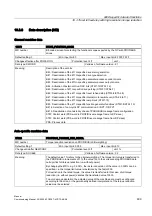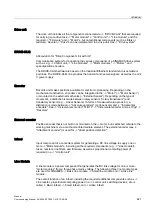
Glossary
Manual
Commissioning Manual, 05/2008, 6FC5397–4CP10–4BA0
623
Servo control
For -> Motors equipped with a -> "Motor encoder", this control type allows operation with a
high level of -> "Accuracy" and -> "Dynamic response". In addition to speed control, position
control can be implemented.
Servo drive
An electric servo drive comprises a motor, a –> "Motor module", a –> "Servo control" and, in
most cases, a speed and position –> "Sensor". Electric servo drives are normally extremely
precise and have a high dynamic response. They are designed for cycle times to less than
100 ms, and often have a short-time overload capacity, which enables quick acceleration.
Servo drives are available as rotary and linear drives Servo drives are e.g. used in the
machine tools, robotics and packaging machines sectors.
SITOP power
Component for the -> Electronic power supply. Example: 24 V DC
Smart line modules
Unregulated line infeed/feedback unit with a diode bridge for the infeed and stall-protected,
line-commutated feedback via -> "IGBTs". The smart line module supplies the DC link
voltage for the -> "Motor modules".
Status Word
Bit-coded -> "Process data" word, transmitted by -> "PROFIdrive" at cyclic intervals to
control the drive states.
Vektorregelung
Vector control (field-oriented control) is a high-performance control method for induction
machines. It is based on an exact model calculation of the motor and two current
components that simulate and accurately control the flux and torque by means of software
algorithms, thereby enabling predefined speeds and torques to be observed and limited
accurately and with a good dynamic response. Two types of vector control exist: The
frequency control (-> "Sensorless vector control") and the speed-torque control with speed
feedback (-> "Encoder").










































